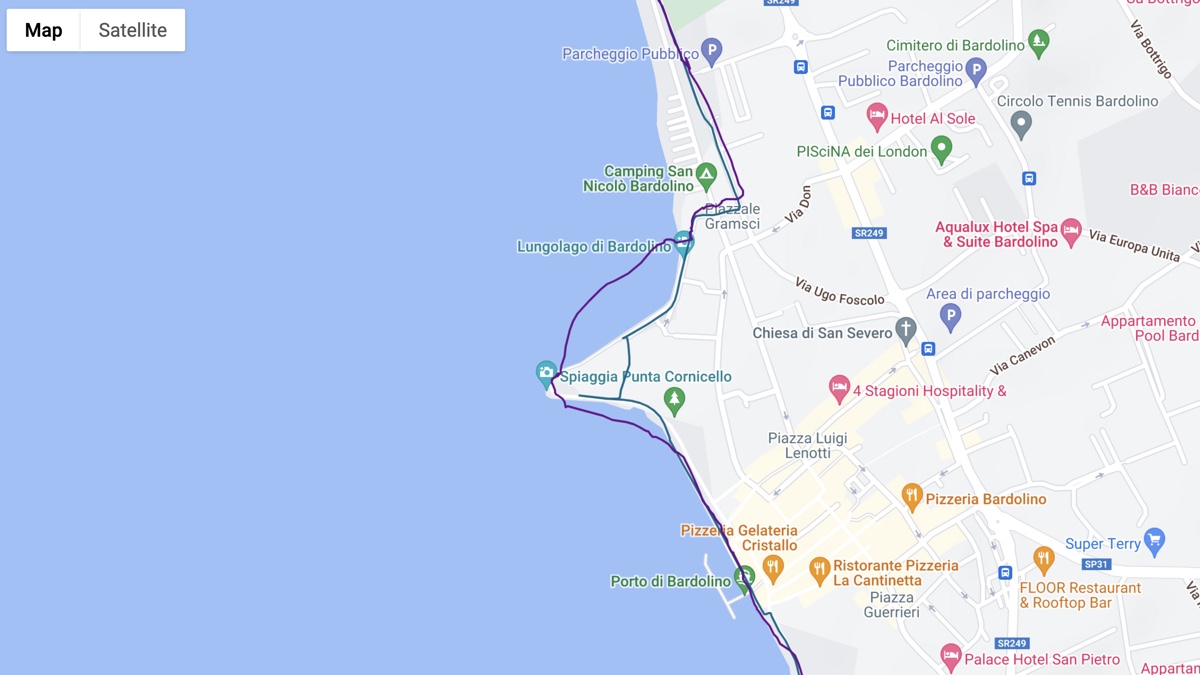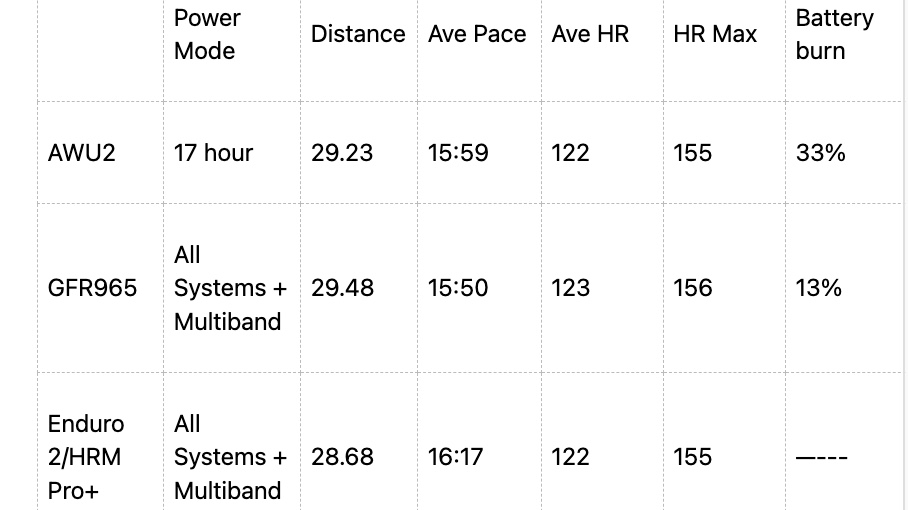
With its longer battery life, more rugged build, and improved navigation tools, the Apple Watch Ultra set a new benchmark for smartwatches with genuine running credentials.
The second-generation Apple Watch Ultra 2 doesn’t add much for runners, but it is the best version of the Apple Watch, made slightly better.
For any runners looking for a top-quality smartwatch with strong running watch features, this should be on the shortlist.
The Apple Watch Ultra talks a good game about its credentials for outdoor adventures – but what about its ultra running credentials? Does the Ultra 2 finally do enough to live up to its name?
I put it to the ultimate multi-day ultra test – running 100 miles in 3 days around Lake Garda in Italy – to find out.
squirrel_12993418
Apple Watch Ultra 2 running features
If you were hoping the watchOS 10 and Apple Watch Ultra 2 upgrades would bring a wave of extra running smarts, you’ll be disappointed. Most of those were part of watchOS 9, which saw improved running form and advanced metrics.
The improvements on Ultra 2 focus more on the general watch experience – brighter screen, more powerful processor, and clever controls – rather than anything running specific.
You still get the dual-frequency precision multiband GNSS, using the L1 and L5 bands to boost the distance and real-time pace tracking accuracy.
There's a brighter display this time, but crucially for us endurance-hungry runners, Apple says the brighter screen and faster, more capable processing don’t cost battery life. However, battery life and GPS-tracking endurance sadly haven’t improved.
In terms of continuous run time, you get the same 12 hours of GPS in normal power mode. That extends to 17 hours with Low Power Mode enabled and up to 35 hours in Low Power Mode with additional things like heart rate and GPS frequency dialed right down.
It’s the best longevity we’ve had yet in an Apple Watch but that’s still significantly lower than many dedicated running watches.
When it comes to price, the Apple Watch Ultra 2 will set you back $799/£799. That’s a chunk pricier than the Garmin Forerunner 965 ($599/£599) but a little cheaper than the Garmin Epix Pro (Gen 2) ($799/£709).
The test
Wareable
To test the Apple Watch Ultra 2’s ultra running capabilities, I ran 100 miles around Lake Garda in 3 days – covering approximately 50km a day, with around 6-7 hours of GPS runtime.
Each day I tested a different Apple Watch Ultra 2 power mode, focussing primarily on the battery life, GPS, and optical heart rate accuracy.
But I also tested the Apple Watch 2’s other ultra credentials including route planning and navigation, the new Compass app waypoints, and extras like music, smart payments, and calls. Any tools you might use for an ultra adventure.
For comparison, I pitted the Apple Watch Ultra 2 up against the Garmin Forerunner 965. Garmin’s AMOLED-screened running watch offers a somewhat similar package on battery life, multiband GPS, music, contactless payments, and navigation. It lacks the smartwatch skills of the Apple Watch Ultra 2 but it’s a potentially cheaper alternative, for running at least.
I also used a Garmin HRM Pro+ chest strap paired with the Garmin Enduro 2 to benchmark the heart rate tracking.
Every day, I took the watches off charge at 100% when I left my accommodation and recorded the battery usage before and immediately after running. I also noted the battery level before putting them back on charge in the evening, to get an idea of the burn rate outside of my runs.
For all three days’ running, I logged the heart rate averages, and maximums and compared the charts closely. For GPS accuracy, I looked at the overall distances, and real-time pacing as I ran and also analyzed the detailed GPS tracks to see how the Apple Watch Ultra 2 coped with its different power and accuracy modes.
Battery life results
Wareable
The Apple Watch Ultra finally alleviated battery anxiety for most runners. It packs enough single-stint juice to handle marathon race day and still be alive the morning after. I've found it can stretch to three days without having to stick it on a charge while training for an hour a day.
The Apple Watch Ultra 2 doesn’t leech too much battery life when you’re not running. I kept my usage to a bare minimum when I wasn’t running and it averaged around 1% per hour.
The exception here is overnight. I had mine charging through the night during this test. However, in other tests, I found the overnight battery burn averaged around 10% (in normal mode). That’s quite a lot and limits the multi-day ultra potential unless you turn it off, or use the Low Power Mode. It wouldn’t last a Marathon des Sables on a single charge.
However, when it comes to runtime endurance, the Apple Watch Ultra 2 puts in a strong performance in all three power modes. While it couldn’t quite match the Garmin Forerunner 965, it's an impressive performance given the extra features you enjoy when you're back from your adventure.
To breakdown the modes tested:
Day 1:
Apple Watch Utra 2: Low Power Mode + reduced HR/GPS (35 hour)
Garmin FR965: UltraTrac
Day 2:
Apple Watch Ultra 2: Low Power Mode (17 hours)
Garmin FR965: All-Systems GNSS mode + Multi-Band: (Up to 19 hours)
Day 3:
Apple Watch Ultra 2 Normal mode (12 Hour)
Garmin FR965: All-Systems GNSS mode + Multi-Band (Up to 19 hours)
Apple Watch Ultra 2 GPS battery life stats
Wareable
Based on my tests, in its lowest power/lowest accuracy mode, I’d estimate you’ll get close to 45 hours of run time with the Apple Watch Ultra 2.
With the Forerunner 965 a slightly longer 55 hours. That staying power opens up the Apple Watch Ultra 2’s potential for 100-mile and 100-km ultras, where you’re likely to be moving between 12 and 30 hours.
In the 17-hour Low Power mode with regular heart rate and GPS readings, the Apple Watch Ultra 2 could well stretch to 24 hours of run time.
That’s plenty for 100km ultras, including getting to the start, running the race, and still having the juice to use Apple Pay to buy the celebratory beer (or hail the Uber) after. It’s also enough for the speedier ultra runners to cover 100 miles.
Running for 7.5 hours on day three, in the highest accuracy 12-hour mode, the Apple Watch Ultra 2 burned 37%.
That suggests you can expect significantly more than Apple’s listed run time of 12 hours. It might even stretch up to 20 hours. Again that’ll cover most runners for the 100km ultra.
Heart rate and GPS accuracy
Heart rate isn’t necessarily the most important metric when you’re running ultras but the Apple Watch Ultra 2’s optical sensor provides plenty of accuracy for the demands of ultra.
Regardless of the power mode, the average heart rate readings were within two beats across the Apple Watch Ultra 2 optical, the Garmin Forerunner 965 optical, and the Garmin HRM Pro+.
The Apple Watch Ultra 2 tended to read a higher HR Max. Sometimes a good 7-12 beats above the chest strap.
Surprisingly, these high max readings happened in the most accurate 12-hour mode and 35-hour power save mode where the Apple Watch Ultra takes less frequent heart rate reads.
Wareable
The Apple Watch Ultra 2’s multiband GNSS was excellent across all the power modes. It matched the Garmin Forerunner 945 and the much pricier Enduro 2 on overall distance and pacing, even in the lower-reading-frequency power-saving mode.
When you dig into the GPS tracks, the Apple Watch Ultra 2 was quite noticeably better at locking onto the paths and roads than the Forerunner 965, too. As you can see in an extreme example below:
Wareable
Real-time pacing was also well-matched and responsive (not that I was moving very fast). And from a GPS perspective, the Apple Watch Ultra 2 has all the power you need for tackling ultra, even in the lowest GPS settings.
Day 1: AWU2 (35-hour mode) vs Garmin FR965 (UltraTrac 34 hours)
Wareable
Day 2: AWU2 (17 hour Low Power Mode) vs Garmin FR965 (All-Systems GNSS mode + Multi-Band: Up to 19 hours)
Wareable
Day 3 – 7:30 run AWU2 (12 Hour) vs Garmin FR965 (All-Systems GNSS mode + Multi-Band: Up to 19 hours)
Wareable
Apple Watch Ultra 2: Routes & Navigation
Wareable
When it comes to navigation, Apple updated the Compass app to automatically log new waypoints for the last known location of a cell signal. You can also see elevation details for waypoints.
There are also TOPO maps for US walking trails, though nothing yet for the UK or Europe sadly. Plus, you can offline sync Apple Maps maps onto the device. So there is a big improvement in navigation smarts coming down the pipe, but right now all the tools I need aren't available natively.
I still found the whole route planning and navigation very disjointed.
To get close to Garmin’s running navigation experience, you still need to look beyond Apple’s native apps and use third-party services like Komoot and AllTrails. Many of which come at a price.
Without these, there’s no simple way to upload (or export) GPX routes and access turn-by-turn navigation. You’re forced to fire up an alternative app to the Workout app. It’s fiddly.
I tested the Compass app’s Waypoint tool several times during the run. On occasions, I needed to change my route and head to a new stopping point along the lake.
The process of adding custom Waypoints requires your phone, which is not what you need 30 miles into a run. And at times Waypoints I added failed to sync with the Watch.
Even when you are navigating to a Waypoint, you’re limited to seeing if you’re moving in the general direction and distance to the location. That’s not hugely useful for navigating roads and paths through built-up environments. So unless you’re somewhere remote, it’s just far easier to fire up Google Maps or Apple Maps on your phone.
Apple Watch Ultra 2: A genuine ultra running watch?
For single-day ultras (even up to the 100-mile distance) where you’re not relying too much on the need to navigate, the Apple Watch Ultra 2 is a genuine contender. If you have access to charging, it’s also got multi-day adventure potential.
You can rely on it to handle all the running basics: GPS and heart rate accuracy is spot on, the battery life will stretch and the screen is excellent in all lights.
Then when you throw in all the smartwatch extras, the Ultra 2 is a far more rounded tool than any of its rivals. The ability to take calls and messages, play music, and pay for that emergency water/ice cream mid-run, elevate its practicality. Not to mention the torch, the safety siren, the last emergency call Waypoint that takes you back to where you had a connection, and being able to hail an Uber if things go wrong.
These were all useful as I plodded through Lake Garda’s towns after the day's running was done.
Verdict
The Ultra 2 is an excellent all-round sports watch for endurance athletes. It genuinely impressed against some of the best in the business, in terms of accuracy and longevity. It deserves more credit in the endurance community than it gets.
The big gap is the navigation. You can piece together a Garmin-like experience using third-party apps. But it’s somewhat disjointed and Garmin’s devices cater much more effectively for the navigational needs of ultra adventures.
So despite the Apple Watch Ultra 2’s stronger capabilities, I wouldn’t have been able to leave my phone at home and circumnavigate Garda using only the watch.
This is perhaps the thing I find most frustrating about the Apple Watch Ultra 2.
It has the makings of a complete ultra-running tool but it’s not quite there yet.
How we test
